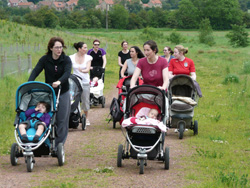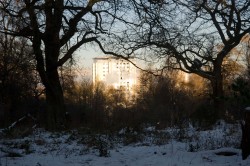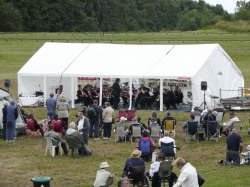Summary
What role do trees, woods and greenspace play in programmes to improve our quality of life?
Summary
Forest Research reviewed research and policy perspectives regarding the social and community benefits provided by greenspace. The team also created a full inventory of all the social evidence from practical programmes in the UK which show how trees and woodland support urban regeneration, place-making and place-shaping.
Key findings
Review
- Different agencies emphasise and measure the influence of trees, woods and greenspace in different ways
- Terminology and concepts have different meanings, especially the concept of ‘place’ between Scotland, Wales and England
- Indicators and measurement frameworks require more refinement and conceptual development, although the level of this problem varies between the concepts, between the three countries, and between forestry and other policy areas
- There is no consensus on the concept of ‘place’ within UK public forestry sector
- The concepts of community cohesion and social capital have received limited attention in forestry
- Research is needed to assess which indicators are suitable for the forestry sector and to develop suitable indicators to measure the influence of woodland on community capacity
- More work is required to measure how woodlands affect people’s perceptions of the places they live in
- Monitoring and evaluation for forestry programmes with a community and/or place-making agenda have been generally poor, lacking baseline data and robust frameworks
Inventory
- Located woodlands close to where people live to secure maximum social benefits
- Trees and woods are an important part of cultural identity: projects, activities and events in urban woodlands can provide a useful expression of local identity and encourage a sense of ownership over wooded places
- Strong evidence that woodlands provide restorative and therapeutic benefits and improve cognitive functioning
- Mixed evidence that trees and woods increase or improve physical exercise
- Trees help to improve perceptions of place, helping to increase residential property values and an enhanced willingness to pay for goods and services
- Concerns about safety, crime and anti-social behaviour act as a barrier to woodland access for many people, especially women, those from an ethnic background and children
- Woodlands and woodland projects help to build a stronger sense of belonging, improve social inclusion and community cohesion, and enhance community capacity to achieve shared goals through increased social capital
Publications
- Inventory of social evidence and practical programmes relating to trees, woods and forests and urban/peri-urban regeneration, place-making and place-shaping
- Place-making and Communities: A review of concepts, indicators, policy and practice
Funders and partners
Commissioned and funded by the Forestry Commission.
Contact
Status
2010.
Inventory of social evidence and practical programmes relating to trees, woods and forests and urban/peri-urban regeneration, place-making and place-shaping

Summary
This is an inventory of social evidence and practical programmes relating to trees, woods, forests and urban/peri-urban regeneration, place-making and place-shaping. It identifies evidence concerning six topic areas:
- Accessibility and usage
- Culture and landscape
- Health and well-being
- Local economy and benefit valuation
- Safety, crime and anti-social behaviour
- Social interaction, sense of community and pride.
Some of the evidence identified in these topic areas, in particular the evidence listed in the social interaction, sense of community and pride section, highlights the linkages between trees, woods and forests and the concepts discussed in the review report.
The inventory report identifies key evidence themes and evidence gaps and also identifies urban regeneration, place-shaping and making programmes in Great Britain in which trees have played the fundamental role.
A second aspect of this research is a review that explores the UK government (including forestry-related) usage and definitions of terms or concepts related to the social and community benefits that can potentially be realised through accessible provision of green space, including woods and trees.
SERG_Peri_urban_regeneration.pdf (PDF-126 KB)
Includes background, objectives, methods and results.
Objectives
- Identify and draw together social evidence relating to the role of trees, woods and forests in urban/peri-urban regeneration, place-making and place-shaping as an easily accessible resource for policy-makers, researchers and practitioners.
- Highlight gaps in the current evidence base.
- Identify and draw together examples of practical urban regeneration, place-making and place-shaping programmes in GB in which trees have played the fundamental role and provide links and/or references to any evidence sources they have produced such as evaluation reports.
Results
The key evidence themes identified were that:
- It is important that woodlands are located close to where people live to secure the maximum social benefits from them.
- Trees and woods are an important part of cultural identity: projects, activities and events in urban woodlands can provide a useful expression of local identity and encourage a sense of ownership over wooded places.
- There is strong evidence that trees and woods can provide restorative and therapeutic benefits and improve cognitive functioning. Evidence relating to the benefits of trees and woods in relation to physical exercise is mixed.
- Trees can be significant elements in improving perceptions of place which can in turn lead to increased residential property values and an enhanced willingness to pay for goods and services.
- Concerns about safety, crime and anti-social behaviour act as a barrier to woodland access for many people, especially women, those from an ethnic background and children.
- Woodlands and woodland-based interventions can help build a stronger sense of belonging, improve social inclusion and community cohesion, and enhance community capacity to achieve shared goals through increased social capital.
Report
peri-urban regeneration, place-making and place-shaping (PDF-2710 KB)
Place-making and communities: a review of concepts, indicators, policy and practice


Summary
This review explores the UK government (including forestry-related) usage and definitions of terms or concepts related to the social and community benefits that can potentially be realised through accessible provision of green space, including woods and trees. These terms include:
- Community empowerment
- Community capacity
- Community resilience
- Community cohesion
- Social capital
- Place, place-making and place-shaping.
The review also explores current indicators that are used to measure achievement of these concepts. It highlights potential gaps in terms of appropriate indicators and future research requirements.
A second aspect to this research is an inventory of social evidence and practical programmes relating to trees, woods, forests and urban/peri-urban regeneration, place-making and place-shaping.
Research summary (PDF-374 KB)
Objectives
- Define key concepts relating to the potential community and place-making benefits which can potentially be realised through trees, woods and forests in the UK government context.
- Explore the usage of these terms in UK government policy, including UK forest policy.
- Identify current indicators used in the UK for their measurement and gaps in terms of applicable indicators in the UK forestry context.
- Identify future research requirements.
Results
The review highlighted that:
- The prominence given to the different concepts varies between different countries and agencies and they are not always used to mean the same thing, especially in regard to the concept of ‘place’.
- There are clear gaps in terms of indicators and measurement frameworks for the concepts discussed, although the level of this problem varies between the concepts, between the three countries, and between forestry and other policy areas.
It also revealed four key points relevant to forestry:
- A full understanding and integration of the concept of ‘place’ has not occurred within UK public sector forestry and the concepts of community cohesion and social capital have received limited attention.
- More work is needed to assess the applicability of a range of indicators in the forestry context. In the case of community capacity a lack of indicators is a common problem across government.
- In terms of place, there is a lack of focus on measuring people’s perceptions of the places they live in and how this is enhanced or not by local woodlands and their relationships with woodland.
- For those forestry programmes with a community and/or place-making agenda, the monitoring and evaluation has thus far been poor, with a lack of baseline date collected and a lack of robust monitoring and evaluation frameworks developed and implemented.
Report
Place-making and Communities: A review of concepts, indicators, policy and practice (PDF-923 KB)
Contact
For further information please contact:
Forest Research
Society and Environment Research Group (SERG)
Roslin
Midlothian
EH25 9SY
